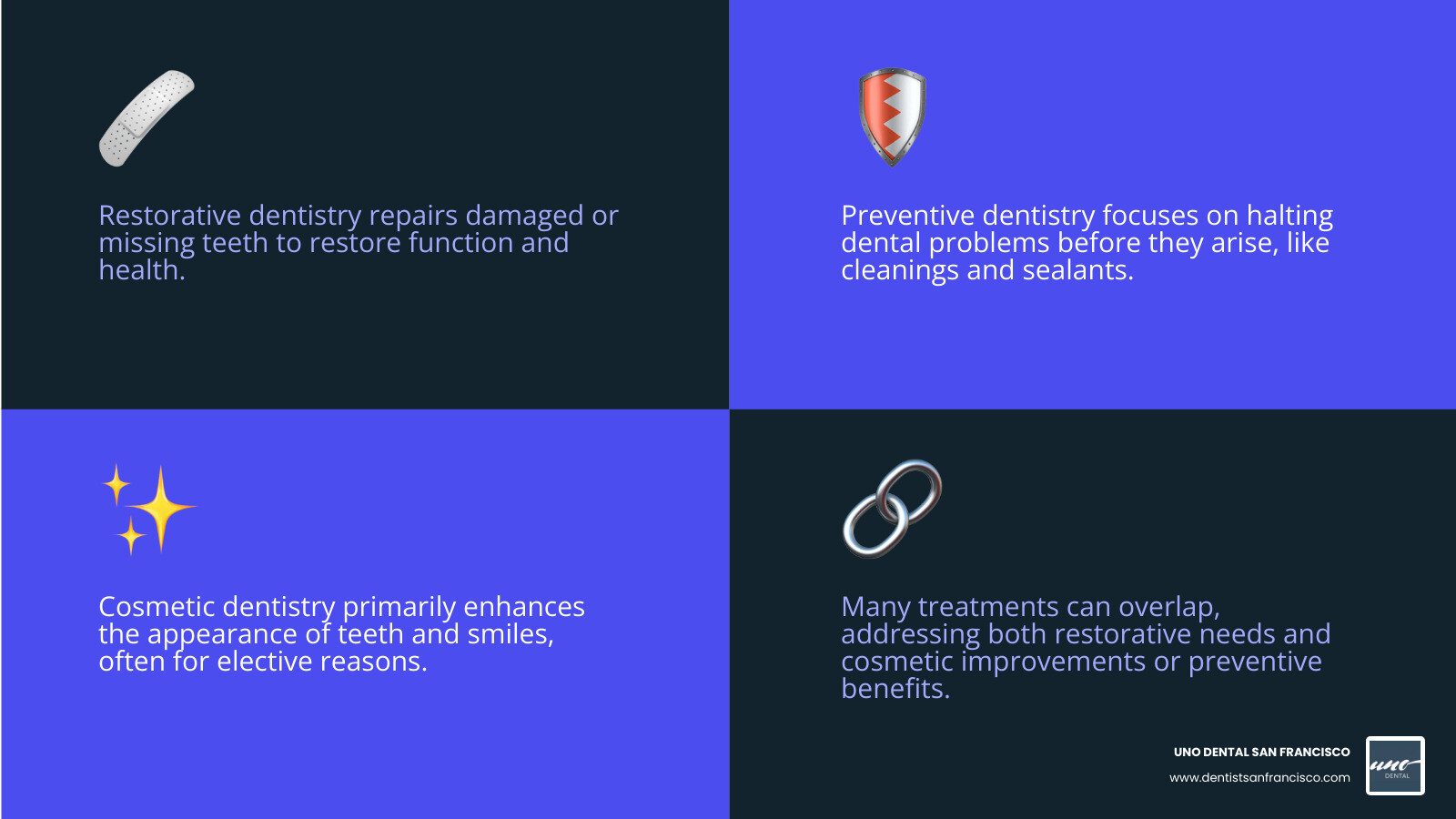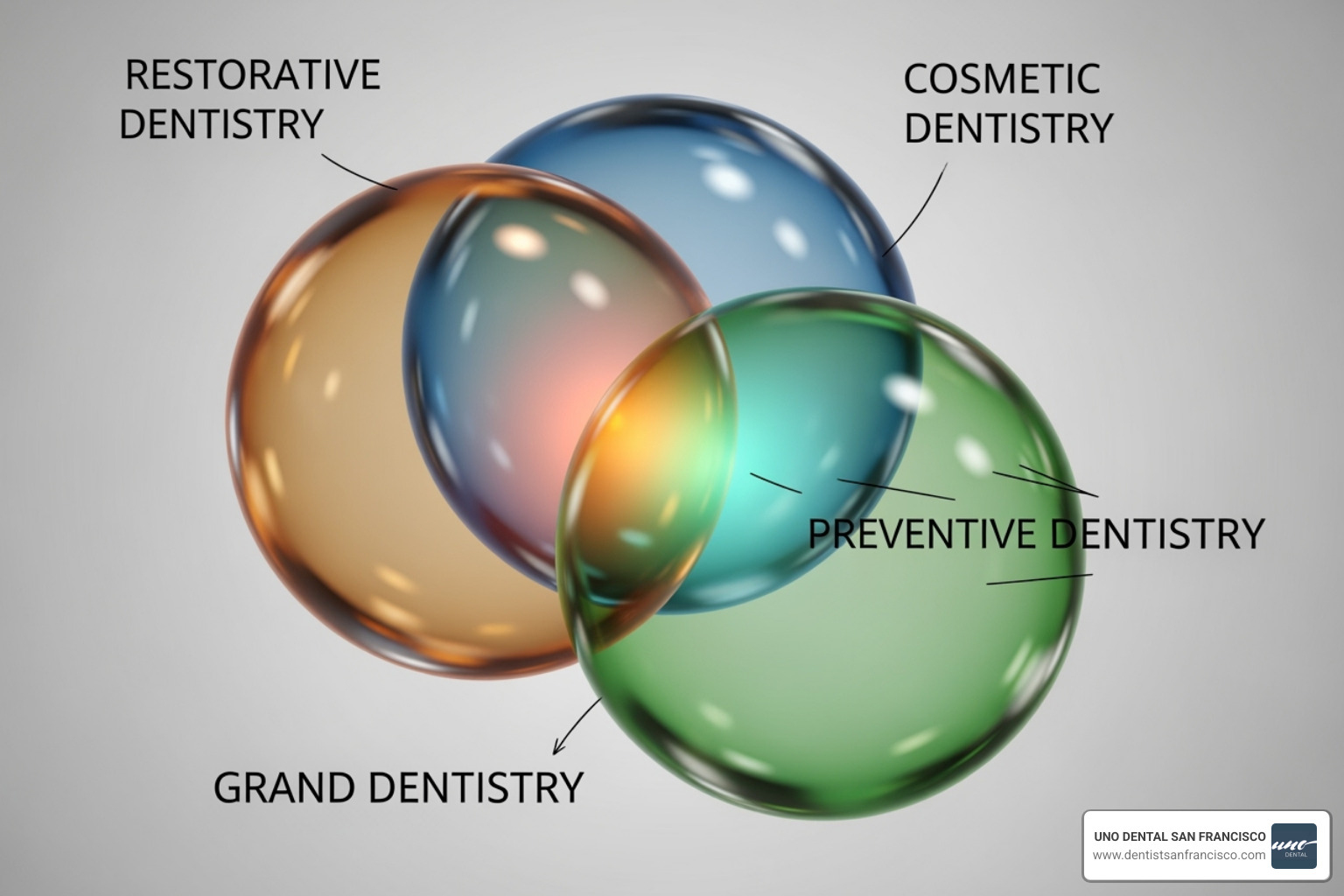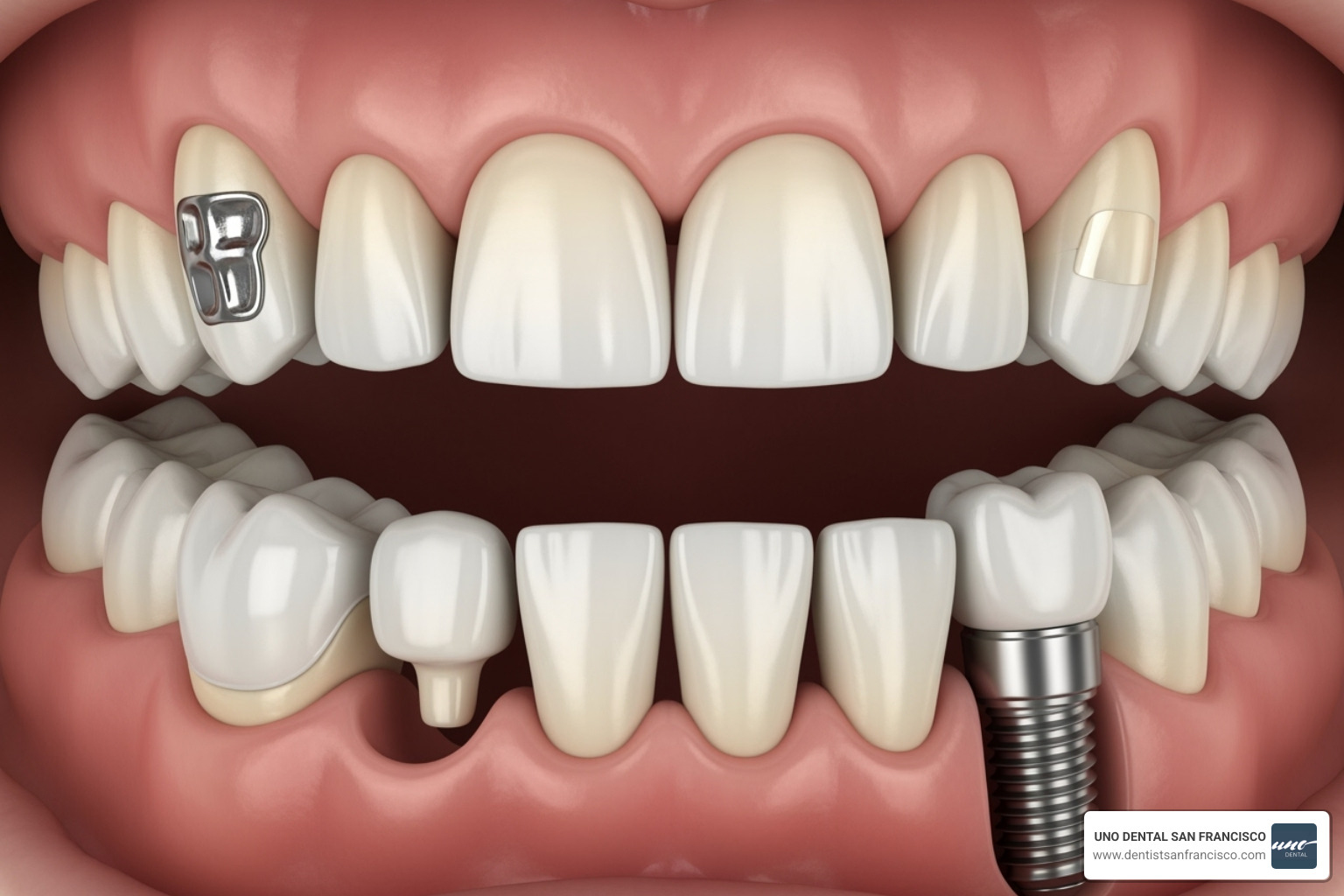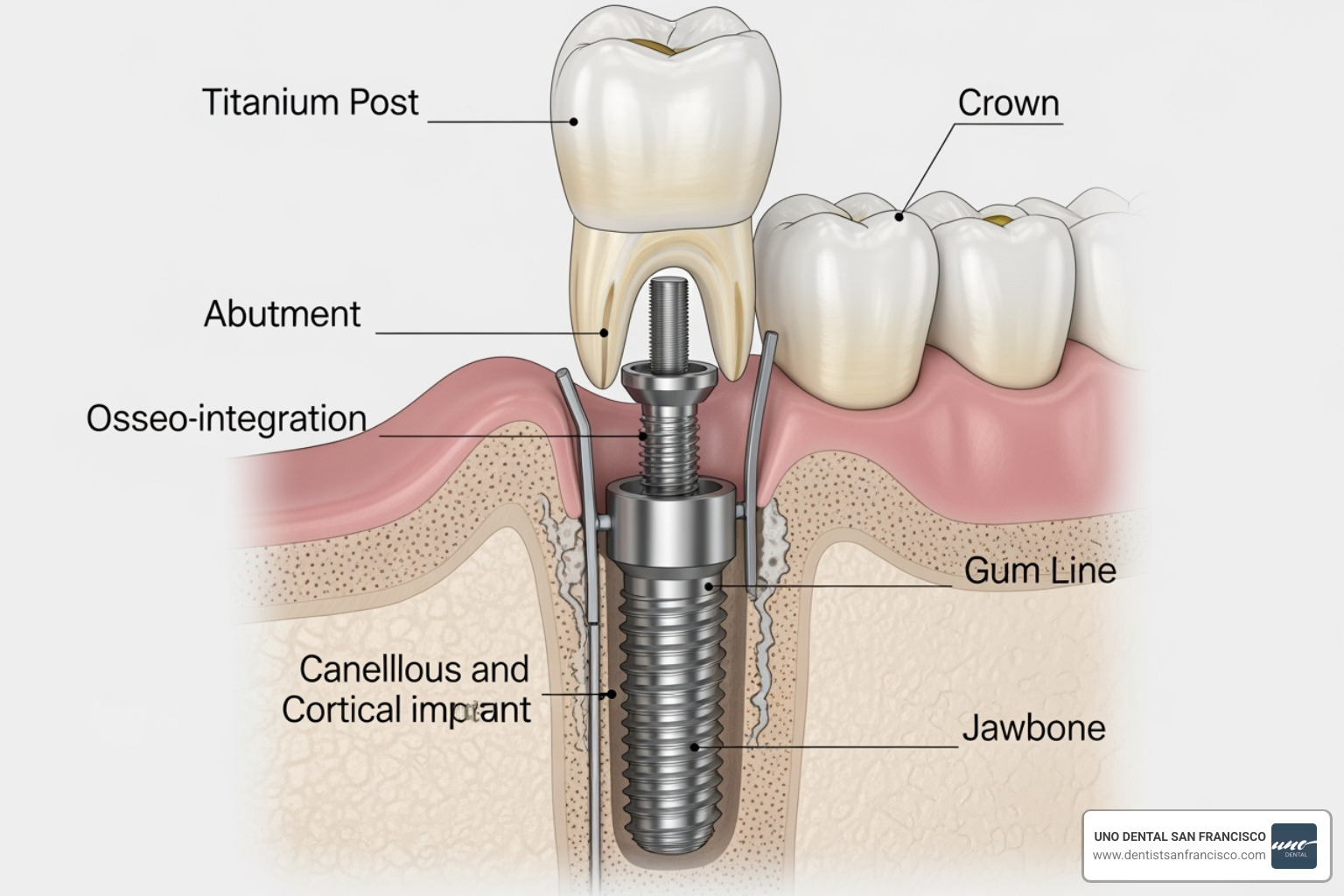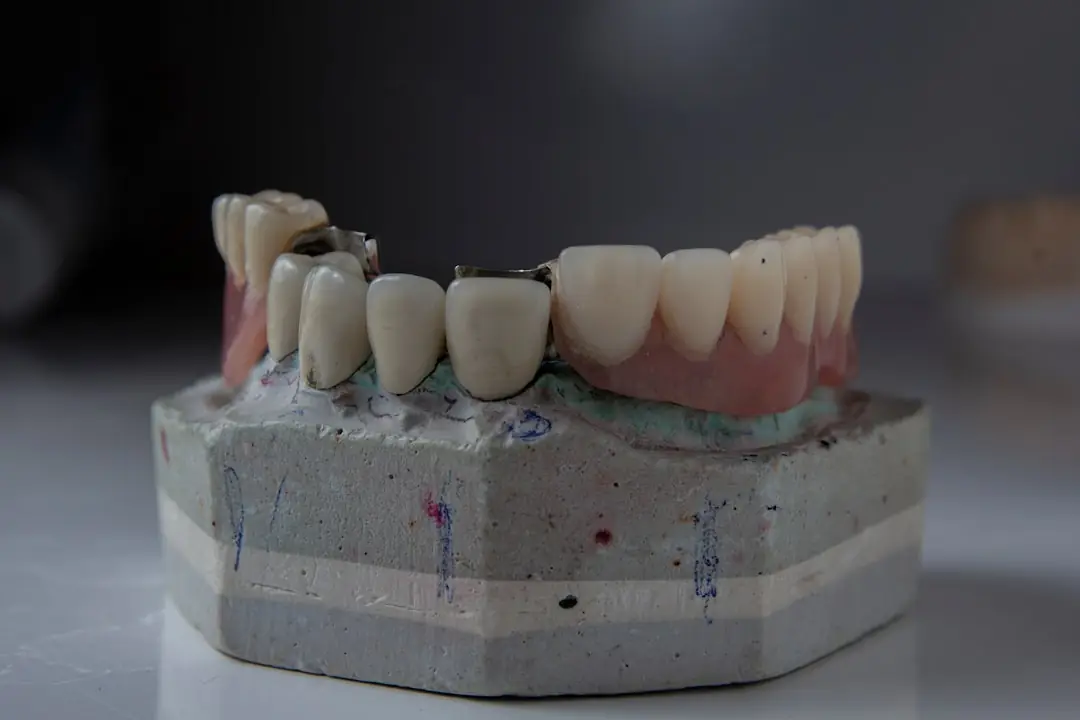
Why Restorative Dentistry is Essential for Your Oral Health
Restorative dentistry is the practice of repairing or replacing damaged or missing teeth to restore both function and appearance. It addresses issues like cavities, cracked or missing teeth, and infections through procedures like fillings, crowns, and dental implants.
The primary goals are to:
- Eliminate pain and discomfort
- Restore proper chewing function
- Prevent further dental problems
- Improve smile appearance
- Maintain facial structure support
Your oral health connects directly to your overall wellness. Untreated dental problems can contribute to systemic issues like heart disease and diabetes, making restorative care essential for your total health.
At UNO DENTAL SAN FRANCISCO, we create personalized treatment plans that address both immediate needs and long-term oral health goals. Our expertise in restorative dentistry allows us to provide comprehensive solutions to help you speak, chew, and smile with confidence.
Glossary for restorative dentistry:
What is Restorative Dentistry and Why is it Important?
Restorative dentistry, also known as prosthodontic dentistry, is a specialized field focused on diagnosing and treating problems with your teeth and their supporting structures. The main goal is to restore your mouth to full health and function, allowing you to eat, speak, and smile confidently. From filling a cavity to replacing missing teeth, it's all about bringing your mouth back to a healthy state.
Your oral health is closely linked to your overall well-being. Research shows that untreated dental problems can increase the risk for serious conditions like heart disease, stroke, and diabetes. Therefore, addressing dental issues with restorative dentistry is a crucial step in protecting your total health. We offer more info about our services and you can find an authoritative overview of dental restorations from reputable sources.
Common Problems That Need Restorative Solutions
Many common issues can be resolved with restorative dentistry:
- Tooth decay and cavities: Bacterial infections that create holes in tooth enamel, which can lead to pain and deeper infections if untreated.
- Chipped, cracked, or broken teeth: Physical damage that can cause pain, sensitivity, and further structural problems.
- Missing teeth: Gaps that can impair chewing, affect nutrition, cause remaining teeth to shift, and lead to jawbone deterioration over time.
- Tooth infections (abscesses): Painful infections in the tooth's inner pulp that can become dangerous if they spread.
- Worn down enamel: Often caused by grinding or acid erosion, this can lead to sensitivity and structural weakness.
Restorative vs. Cosmetic and Preventive Dentistry
It's helpful to understand the different focuses in dentistry:
- Preventive dentistry aims to stop problems before they start, through services like cleanings and sealants.
- Cosmetic dentistry focuses purely on aesthetics, with elective treatments like teeth whitening or veneers to improve a smile's appearance.
- Restorative dentistry addresses medical necessity first. Its primary goal is to repair damage and restore function. While treatments often improve appearance, the core reason is health-related. The key distinction is medical necessity versus elective choice.
Understanding the Goals of Restorative Dentistry
Restorative dentistry treatments aim to achieve several important goals:
- Eliminate pain: Provide relief from toothaches and sensitivity.
- Improve chewing function: Restore the ability to eat comfortably and efficiently, which aids digestion and nutrition.
- Prevent future dental issues: Treat existing problems to reduce the risk of more serious complications later.
- Improve smile appearance: Modern materials blend seamlessly with natural teeth for an aesthetic result.
- Maintain proper tooth spacing and support facial structure: Replacing missing teeth prevents shifting and the jawbone deterioration that can alter facial appearance. Dental implants are especially effective at this.
Your Guide to Common Restorative Dental Procedures
At UNO DENTAL, we combine high-tech innovation with holistic care. We use advanced technology like CAD/CAM (Computer-Aided Design/Computer-Aided Manufacturing) and CEREC same-day restorations, which allow us to design, create, and place custom crowns or fillings in a single visit. This saves you time and reduces anxiety.
Restorative dentistry procedures are either direct (completed in your mouth in one visit, like fillings) or indirect (custom-made in a lab or with in-office tech, like crowns and bridges).
Dental Fillings
Fillings are the most common restorative dentistry procedure, used to repair cavities and minor chips. The process involves removing the decayed tooth portion and filling the space to restore its shape and function. We use modern composite resin fillings, which are tooth-colored and blend seamlessly with your natural teeth. As part of our holistic, health-first approach, we only offer mercury-free fillings. With proper care, fillings can last 10 to 15 years or more.
Dental Crowns
Often called "caps," dental crowns are protective covers for teeth that are severely damaged, decayed, or have undergone a root canal. They restore the tooth's strength and appearance. The process involves preparing the tooth, taking a digital scan, and cementing a custom-made crown over it. Materials like porcelain, ceramic, and zirconia offer excellent aesthetics and strength. A crown can last 5 to 15 years, and often much longer with good care.
Dental Implants
Dental implants are the gold standard for replacing missing teeth. They are the only option that replaces the tooth root, preventing jawbone loss. The process involves surgically placing a titanium post into the jawbone, which fuses with the bone over time (osseointegration). An abutment and custom crown are then attached. Titanium is used for its strength and biocompatibility. Implants can last 15 to 20 years or even a lifetime, making them an excellent long-term investment. Find More info about dental implants on our site or review AAID information on dental implants.
Dental Bridges
Dental bridges fill the gap left by one or more missing teeth. A bridge consists of an artificial tooth (pontic) anchored by crowns on the adjacent natural teeth (abutment teeth). This restores your bite and prevents neighboring teeth from shifting. For multiple missing teeth, implant-supported bridges offer superior stability without altering natural teeth. A dental bridge can last 10 to 15 years or longer with proper care.
Dentures
Modern dentures are comfortable, natural-looking removable appliances for replacing multiple teeth. Full dentures replace all teeth in an arch, while partial dentures fill gaps when some natural teeth remain. For improved stability, implant-supported dentures snap onto dental implants, eliminating slippage and improving chewing function. Dentures typically last 5 to 10 years and require adjustments over time. The ADA information on dentures offers more details.
Inlays and Onlays
Often called "indirect fillings," inlays and onlays are used when damage is too extensive for a filling but not severe enough for a full crown. An inlay fits within the tooth's cusps, while an onlay covers one or more cusps. These custom-made restorations are bonded to the tooth, preserving more natural tooth structure than a crown. Made from porcelain or composite resin, they are incredibly durable and can last up to 30 years.
Choosing the Right Treatment: Key Factors to Consider
Finding the right restorative dentistry solution requires a personalized approach. Your journey at UNO DENTAL begins with a comprehensive patient consultation to understand your goals and concerns. We consider several key factors to create your individualized treatment plan:
- The number of missing or damaged teeth.
- Your jawbone health, which is crucial for supporting dental implants.
- Your overall health and any medical conditions that may affect treatment.
- Your patient preferences, including budget, aesthetic goals, and comfort.
Comparing Your Options: Longevity, Cost, and Care
This table provides a general comparison of common restorative dentistry procedures. Costs and lifespan can vary based on your specific case and oral hygiene.
| Restorative Procedure | Average Lifespan (with proper care) | Typical Cost Range (per tooth/appliance) | Maintenance Required |
|---|---|---|---|
| Dental Fillings | 10 to 15 years or longer | $150 to $1,100 per tooth | Regular brushing, flossing, dental check-ups. Avoid chewing hard foods. |
| Dental Crowns | 5 to 15 years | $800 to $3,000 | Regular brushing, flossing, avoid very hard/sticky foods. Annual dental visits to check integrity. |
| Dental Bridges | 10 to 15 years or longer | $1,500 to $5,000 | Regular brushing, flossing (especially under the bridge), professional cleanings. |
| Dental Implants | 15 to 20 years, often lifetime | $1,000 to $90,000 (single to full mouth) | Regular brushing, flossing, professional cleanings. Similar to natural teeth. |
| Dentures | 5 to 10 years | $1,000 to $5,000 | Daily cleaning, removal overnight (for traditional), regular relining/adjustments. |
Navigating Costs and Dental Insurance
The cost of restorative dentistry varies based on the procedure, materials, and complexity. Many treatments are considered medically necessary, meaning they are often partially covered by dental insurance. Cosmetic procedures, in contrast, typically are not.
Insurance coverage differs greatly between plans. We recommend checking with your provider to understand your benefits and potential out-of-pocket costs. To help manage expenses, UNO DENTAL offers payment plans and financing options.
Recovery, Aftercare, and Potential Side Effects
Recovery varies by procedure, from minimal downtime for a filling to a longer healing period for dental implant placement. Common side effects like temporary tooth sensitivity, mild discomfort, or swelling are normal and typically manageable with over-the-counter pain relievers.
Proper aftercare is crucial for the longevity of your restoration. Key principles include:
- Excellent oral hygiene: Brush and floss regularly to prevent plaque buildup.
- Dietary considerations: Avoid very hard or sticky foods, especially right after treatment.
- Follow-up appointments: Attend all scheduled visits to monitor healing and make adjustments.
- Avoiding harmful habits: Don't chew ice or use your teeth as tools.
Always contact us if you experience persistent pain or feel that a restoration is loose. You can also refer to Patient aftercare information for general guidance.
Frequently Asked Questions about Restorative Treatments
Here are answers to the questions we hear most often about restorative dentistry in our San Francisco practice.
How long do dental restorations last?
The lifespan of a restoration depends on the material, procedure, and your oral hygiene. With proper care, fillings can last 10-15+ years, crowns and bridges 5-15+ years, and dentures 5-10 years. Dental implants are the most durable, often lasting 15-20 years or even a lifetime. Regular check-ups are key to maximizing the longevity of your dental work.
Is restorative dentistry painful?
No. Modern restorative dentistry is designed to be comfortable. We use effective local anesthetics to numb the area completely during the procedure. For patients with dental anxiety, we also offer sedation options to ensure you remain relaxed. While you may experience mild, temporary sensitivity or discomfort afterward, this is typically manageable with over-the-counter pain relievers.
Which materials are best for restorative dentistry?
The "best" material depends on your specific needs. At UNO DENTAL, we prioritize safe, durable, and biocompatible materials.
- Composite resin is ideal for tooth-colored fillings.
- Porcelain and ceramics are excellent for crowns and inlays, as they mimic natural tooth enamel.
- Zirconia offers superior strength for crowns and bridges.
- Titanium is the gold standard for dental implants due to its strength and ability to fuse with bone.
In line with our holistic philosophy, we only use mercury-free fillings. We will discuss the pros and cons of each material to help you make an informed choice.
Restore Your Smile with Confidence
Your smile is a vital part of how you express yourself. When dental problems arise, restorative dentistry offers a long-term solution to restore function, improve health, and give you back the confidence to live fully.
At UNO DENTAL SAN FRANCISCO, our holistic approach combines high-tech care with genuine human connection. We create individualized treatment plans custom to your unique needs, lifestyle, and goals. Using advanced technology like CEREC same-day restorations, we provide precise, comfortable, and efficient care all under one roof.
If you have damaged, decayed, or missing teeth, you don't have to live with the discomfort or limitations. Restorative dentistry has a solution for nearly every dental problem, allowing you to eat, speak, and smile without hesitation.
Ready to take the first step? We'd love to help you achieve the healthy, confident smile you deserve. Schedule your free virtual smile consultation today and let's explore your restorative dentistry options together.
